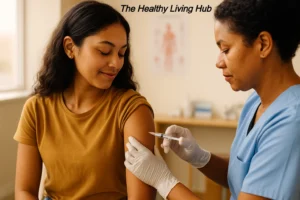HPV Vaccine Cervical Cancer: Why Rates Are Falling for Everyone—even the Unvaccinated
The science is now clear: wide HPV vaccination doesn’t just protect people who get the shot—it also reduces infections and cervical cancer risk across whole communities. That means fewer high-risk HPV infections and fewer cervical precancers, translating into lower cancer rates over time. Understanding how HPV Vaccine Cervical Cancer prevention works (and who should get vaccinated) can help families make confident, evidence-based choices.

What’s New: Community Protection (Herd Effects) in Action
Large multi-study analyses now show strong herd immunity benefits: even unvaccinated people are seeing sharp drops in infections with the most dangerous HPV types (like 16 and 18) when vaccine coverage is high. Recent pooled data report ~72% lower HPV-16/18 infections and ~76% lower infections with 4-valent vaccine types among unvaccinated participants—clear evidence that community-level protection is working. JAMA Network+1
This community effect stacks on top of direct protection for vaccinated people and is a major reason countries aim for very high coverage in adolescents.
The Bottom Line for Risk: Precancers Are Plummeting
In the U.S., among screened women aged 20–24—the first cohorts offered HPV vaccine in adolescence—cervical precancers fell ~79–80% from 2008 to 2022. These declines match what we’d expect when vaccine-preventable HPV infections collapse. CDC
CDC summaries echo the pattern:
88% drop in vaccine-type HPV infections among teen girls;
81% drop among young women;
40% drop in the share of cervical precancers caused by the highest-risk types in vaccinated women. CDC
HPV Vaccine Cervical Cancer: Why It Works
HPV vaccines train the immune system to block infection from high-risk HPV types that cause nearly all cervical cancers. With fewer infections spreading, both vaccinated and unvaccinated people encounter the virus less often—this is the essence of herd protection. Scientific reviews and public-health data now document these population-level gains across multiple countries. PMC+1
US/UK Snapshot: Momentum—and Gaps to Close
United States: Vaccination has driven down infections and precancers; ongoing surveillance continues to tie these declines to the adolescent program. CDC+1
United Kingdom: England’s plan targets elimination of cervical cancer by 2040, supported by a simplified single-dose school program introduced in 2023 and strong evidence that the vaccine prevents ~90% of cases. However, uptake still varies by area, so closing coverage gaps is a priority. NHS England+1
Who Should Get Vaccinated—and When?
Primary schedule (US): CDC recommends HPV vaccination at ages 11–12 (can start at 9), with catch-up through age 26. For ages 27–45, shared decision-making is advised based on individual risk. Long-term monitoring shows the vaccine is safe, effective, and durable. CDC+1
UK program: Offered routinely in school years (now single dose for most); check local NHS guidance for timing, catch-up, and special circumstances. NHS England
Screening still matters. Even with vaccination, routine cervical screening (HPV testing/Pap) remains essential, because not all cancers are vaccine-preventable and some people miss vaccination. NHS England
HPV Vaccine Cervical Cancer: Myths vs Facts (Quick Check)
Myth: “Only vaccinated people benefit.”
Fact: High coverage reduces virus circulation, protecting entire communities, including the unvaccinated. JAMA Network+1Myth: “We don’t see real-world impact yet.”
Fact: U.S. data show steep, sustained drops in cervical precancers in the first vaccine-eligible cohorts. CDCMyth: “Protection might not last.”
Fact: Over 15 years of monitoring supports long-lasting protection and a strong safety record. CDC
What This Means for You (US/UK)
Parents & carers: Book the HPV shot on time (age 11–12) and follow local guidance for catch-up.
Young adults: If you missed it, talk to your GP/primary-care clinician about catch-up.
Everyone: Keep up with screening when invited—vaccination and screening work together to prevent cancer. NHS England
Practical Next Steps
Check your status (vaccine doses + screening due dates).
Book appointments for yourself or your child.
Encourage peers—herd effects grow as coverage grows.
Stay with credible sources (CDC, NHS, WHO) for guidance, not rumors. CDC+1
Internal Link (keep readers on your site)
For long-term wellbeing, see our guide Bone and Joint Health After 50 – 7 Expert Tips — stronger mobility supports an active lifestyle and overall preventive health.
Conclusion & CTA
HPV vaccination is delivering what it promised: fewer dangerous infections, fewer precancers, and a path toward eliminating cervical cancer in our lifetime. The HPV Vaccine Cervical Cancer story is one of community protection—your choice to vaccinate helps protect you and others.
Take action today: check your vaccine and screening status, book what’s due, and share accurate information with family and friends.
